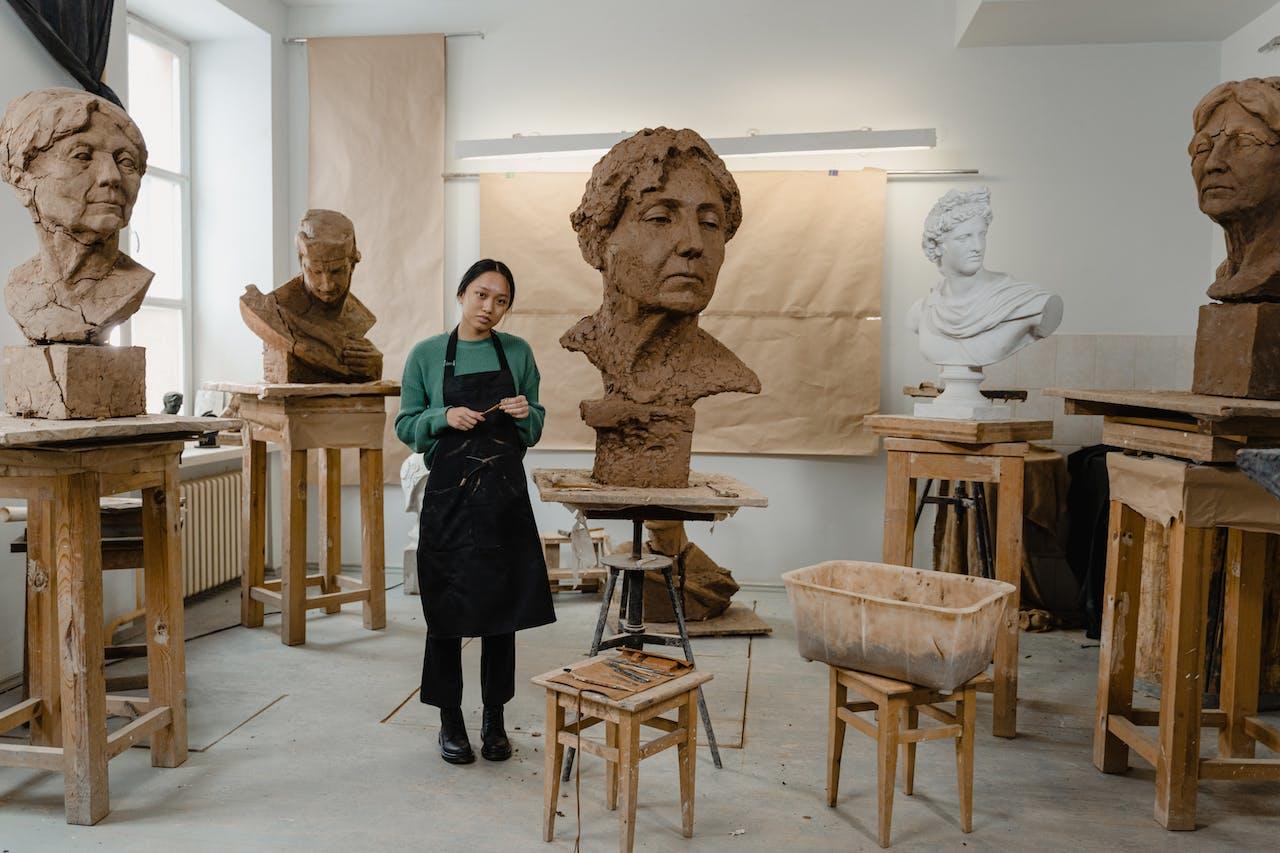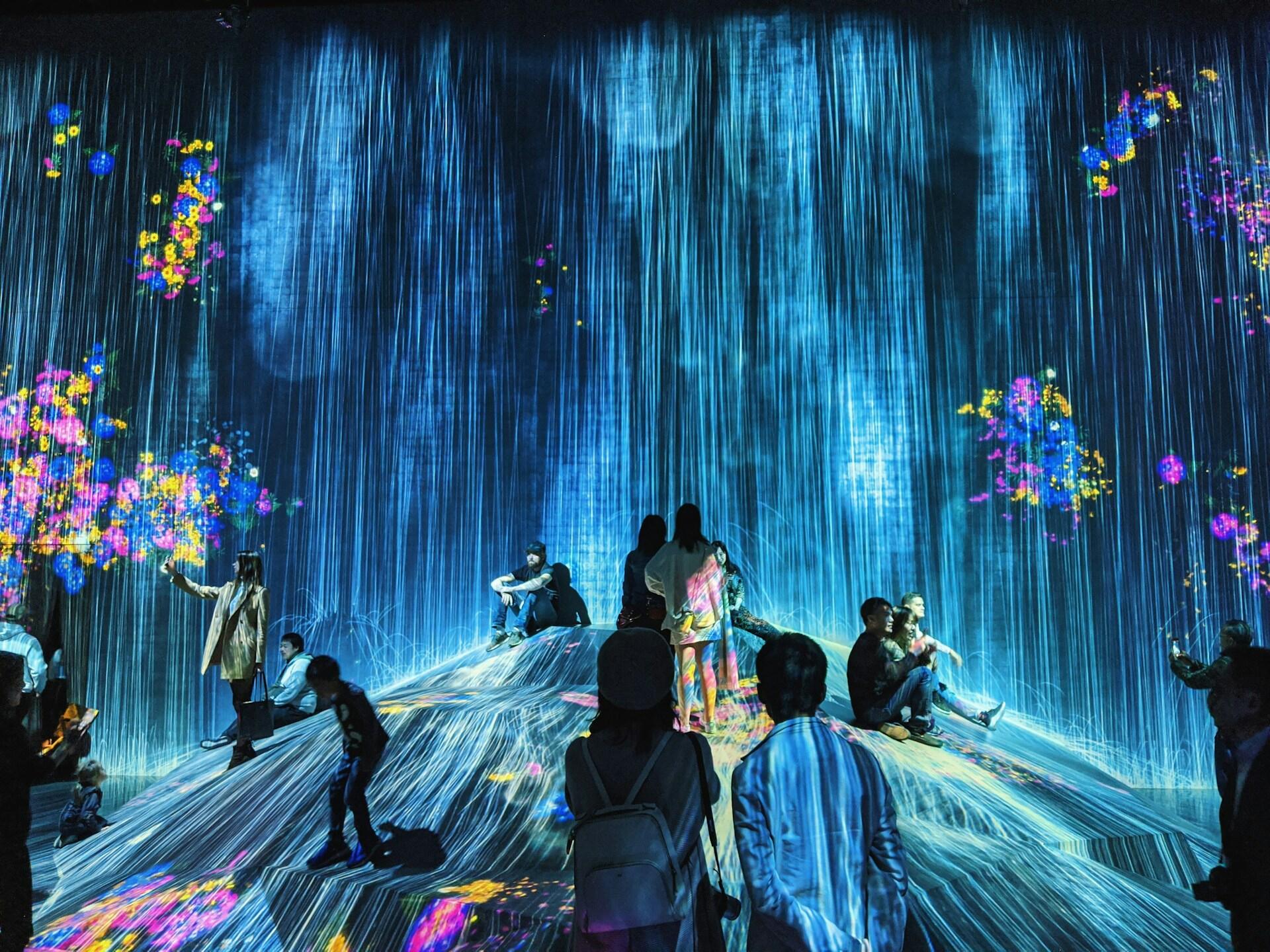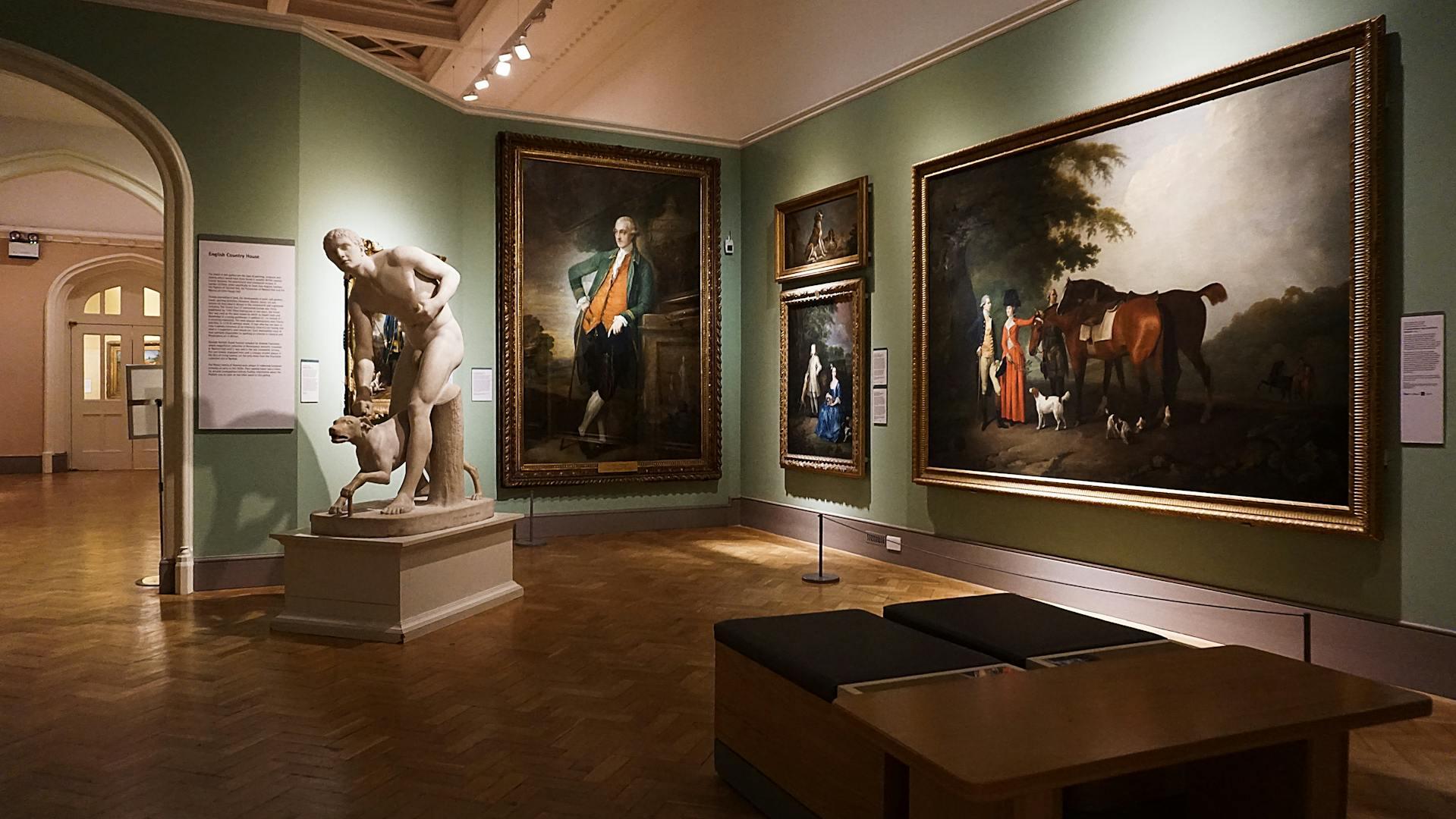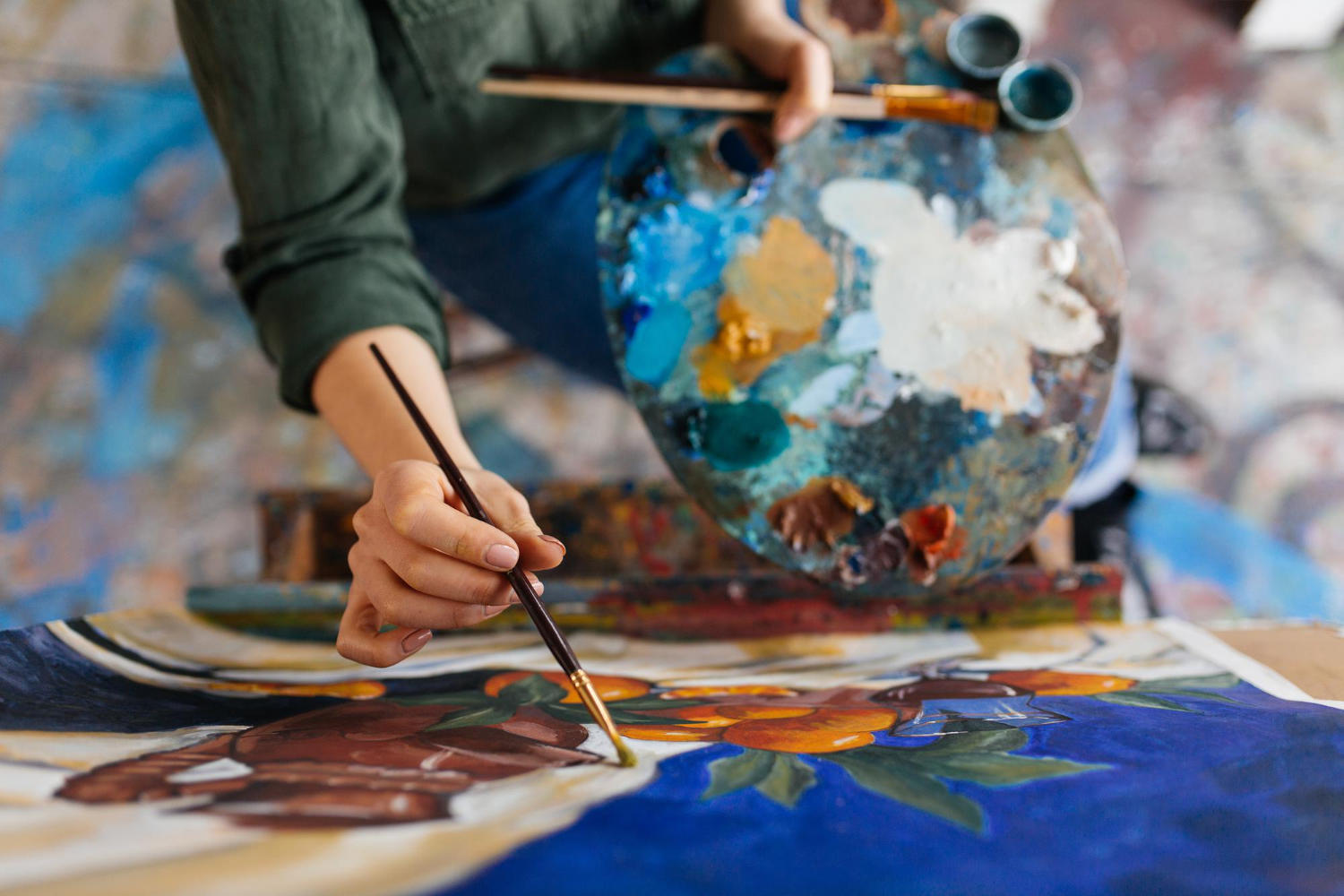Art is an important aspect of society, and has been for thousands of years. You, as a prospective art student, probably already know all this! But, how can you use an art degree in this modern world, where people can’t typically just “be artists” anymore, like Van Gogh or Michelangelo? Here, you’ll learn some of the practical applications for your art degree in the modern world.
Before you dive in, here's a quick run-down of the list of art degrees available in terms of level.
| Degree | Average Duration |
|---|---|
| Associates Degree | 2-4 years |
| Bachelors Degree | 4 years |
| Masters Degree | 2-3 years |
| Doctorate Degree | 2-6 years |

Types of Undergrad Art & Design Degrees
First, what are the different types of undergraduate art degrees you can earn? What are the different art majors and design majors you can consider? Should you pursue an art degree or a design degree, and what’s the difference?
Art is not what you see, but what you make others see.
Edgar Degas, French impressionist and artist
Bachelor of Science
“Science?” you might be saying. “Really?”
Yes! A Bachelor of Science degree can be awarded to people studying art because it means that they also received education on things like business, math, and science.
For example, I received a BS in Graphic Design because I also studied business practices, communications, and general courses like history, physiology, and algebra as part of my college’s mandatory curriculum.
Common Bachelor of Science (BS) degrees in the artistic realm include:
- Digital Design
- Graphic Design
- Advertising
- Digital Arts
- Art Therapy
- Video Game/Game Art, Development, and Programming
- Web Design
- Animation, Computer Animation
- Digital Cinematography
- Character and Environment Design
- Interior Design
- Textiles/Fashion Design & Merchandising
- Drafting Design
- Interactive Media Design
- Graphic Communications
- UX & UI Design
- Packaging
- Recording Arts
- Film & TV
- Directing
- Film & Culture
- Theater Education
- Dance
- Music Business/Industry
- Songwriting
- Media/Video Production
- Special Effects
- Music Composition & Theory
- Entertainment Management
- Audio Engineering
- Filmmaking
- Writing/Creative Writing
- Furniture Design
- Photography
Notice that these arts are not typically studio art, so if your dream is to become a ceramicist or painter, you’ll need a different or further experience.
Bachelor of Art
A BA is usually granted to students specializing in Humanities, Arts, Social Sciences, Linguistics, Cultural Sciences, and occasionally, Informatics and Business Sciences.
The biggest difference between a BA and a BS is that in a BA program, your skills in things like critical thinking and communication on a human level will be more developed. You will also have a stronger foundation in the humanities.
Psychiatrists and psychologists typically start out by earning a BA rather than a BS, even though you’d think that psychology is a science. Alas, the higher education structure is old, and therefore, a bit confusing to our modern ways of thinking.
Common Bachelor of Arts (BA) degrees include:
- Art/Art Studies
- Jewelry & Metal Arts
- Studio Art
- Art History & Criticism
- Photography & Film
- Painting, Sculpting, Ceramics, Illustration, Printmaking
- Media Arts & Design
- Animation
- Interdisciplinary & Intermedia Studies
- Audio Production & Sound Design
- Writing/Creative Writing
- Visual Communication and Digital Media
- Interior Design
- Animation & Game Design
- Graphic Design
- Art Therapy & Education
- Fashion Design & Merchandising
- Digital Storytelling
- Visual Effects
- Visual Technology
- Theater/Musical Theater (Theatre)
- Music Production/Music Business
- Music/Musical Instruments/Vocal Studies
- Drama / Acting / Performance
- Theater Arts
- Theater Production
- Theatrical Design and Technology
- Speech & Dance
- Theater Education
- Music Education
- Music History
- Film History
- Film Production / Motion Pictures / Filmmaking
- Cinematography
- Film Studies/Cinema
- Film, Media, & Pop Culture
- Furniture Design
Many of the concentrations of studies in BA and BS programs overlap. The choice is yours whether you want to have a more technical education (BS) or a more humanities-based education (BA) for your degree in art.

Bachelor of Arts and Science (BASc or BAS)
This type of degree is rather uncommon in the United States, but isn’t unheard of. The curriculum differs between institutions, so you will need to research the course structure of each college or university you are considering carefully to see what exactly it entails.
The gist is that a BASc or BAS (not to be confused with a Bachelor of Applied Science, which is also called a BAS) is an interdisciplinary study with a lot of creative freedom for the student. In this way, the degree is closer to a BS than a BA, because, in addition to your chosen major, you also study many other subjects to get a very well-rounded education.
The most common BASc degrees include:
- Interdisciplinary Studies/Arts
- Media Arts & Sciences
- Digital Arts & The Humanities
- Art & Technology
- Visual Studies
You can see that this type of program gives students a very broad degree description rather than a concentrated one.
The arts are not a frill. The arts are a response to our individuality and our nature, and help to shape our identity. What is there that can transcend deep difference and stubborn divisions? The arts. They have a wonderful universality. Art has the potential to unify. It can speak in many languages without a translator. The arts do not discriminate. The arts lift us up.
Barbara Jordan, Former US Representative and lawyer
Bachelor of Fine Arts (BFA)
When you study for a BFA, about two-thirds of your courses will directly relate to your chosen major. The other third will be general studies like history and math (the liberal arts portion of the degree). This is different from BA and BS degrees, where the general education courses account for half to two-thirds of your studies.
This type of degree is reserved for the visual, fine, and performing arts, meaning you cannot get a BFA in something like psychology, even though you can get a BA for it.
BFA programs are characterized by intensive study and practice in the art, meaning that in addition to studying theory and history, you are simultaneously learning and creating practically. For example, you’ll take a theater history class and also an acting class.
Upon graduating from a BFA program, you should receive a physical diploma or a digital, verifiable transcript as official proof of your education and achievements.
Some of the most common areas of study for BFA students include:
- Sculpture
- Printmaking
- Drawing, Painting, Illustration
- Studio Art
- Film Arts
- Architecture
- Digital Arts
- Visual Arts
- Fine Art
- Graphic Design
- Interactive Media
- Animation
- Game Art & Design
- Performing Arts
- Creative Writing
- Art History
- Visual Communications
- Architectural Design
- Product / Packaging Design
- Fashion Design
- Photography
- Interior Design
- Furniture Design
Bachelor of Science (BS)
Bachelor of Arts (BA)
Bachelor of Fine Arts (BFA)
Master of Arts (MA)
Master of Fine Arts (MFA)
Other Undergrad Degree Types
When searching for programs, you'll find that different schools may offer a wider variety of degree names than what's listed here. Degree types can vary between institutions, states, and countries. Some other ones to look out for include:
- Bachelor of Design (BDes)
- Bachelor of Visual Arts (BVA)
- Bachelor of Performing Arts (BPA)
- Bachelor of Creative Arts (BCA)
- Bachelor of Music (BM)
If you have any doubts when researching colleges, you should reach out to their admissions team to learn more.
I found I could say things with color and shapes that I couldn't say any other way - things I had no words for.
Georgia O'Keeffe, Painter
Associate Degrees in Art
For many artistic professions, an associate degree can be a great option. It can give you the foundational education required to learn more on your own or gain the credentials required for work. You can also get a taste and decide if you want to pivot your education, artistic or otherwise, or supplement your existing education. Many students who seek an associate degree do so with the intention of transitioning into another major (likely an advanced version of their associate studies) or directly into a job.
Note that an “Associate of Arts (AA)” degree usually doesn’t have to do with the types of art addressed in this article. Instead, it focuses on liberal arts studies for use in fields like accounting, business, and education.
Here are some of the options available for associate's degrees in art:
- Associate of Occupational Studies (AOS)
- Associate of Applied Science (AAS)
- Associate of Fine Arts (AFA)
- Associate of Arts in ___
- You’ll have a specific focus associated, such as Performing Arts, Fine Arts, Creative Arts, etc
Many schools offer Associate Degree programs in a wide variety of art and design disciplines. You can find an associate program in just about any field you can find a bachelor's degree in.
Graduate Degrees in Art & Design
When pursuing a graduate degree in art, it’s more important to choose the specialization that most resonates with you, because you’ll be spending a lot of time doing that activity. Think of how much time a medical student spends studying anatomy, interning at hospitals, and practicing different kinds of medicine. That will be you, but with art.
Master of Science (MS)
Just like the BS degree, it’s possible to obtain a Master of Science degree in all types of art-related fields, such as:
- Critical, Curatorial, and Conceptual Practices in Architecture
- Human-Centered Design and Engineering
- Game Science and Design
- Instructional Design
- Design and Merchandising
- Music Education
- Interior Architecture
- Publishing
- Digital and Print Media
- Urban Planning
- Historic Preservation
Master of Fine Arts (MFA)
Most people probably think of this degree when they think of a professional artist. An MFA program typically focuses on studio art disciplines like painting, sculpture, photography, etc. It often involves creating a substantial body of work as a thesis.
A man paints with his brains and not with his hands.
Michelangelo
Master of Arts (MA)
This is an umbrella term for many different degrees. For example, you can have an MA in:
- Art History
- Art Theory
- Design Management
- Fashion Design
- Textile Design
- Interior Design
- Film & Media Production
- Industrial Design
- And many, many more
Master of Design (MDes)
This type of program is more technical in nature, emphasizing the application of design principles in various fields like product design, graphic design, and user experience (UX) design. Those who pursue an MDes degree typically go on to work in creative technical fields as opposed to more artistic fields. They often work on projects that have to do with improving society.
Master of Architecture (MArch)
An MArch program focuses on architecture and related disciplines, including urban design, landscape architecture, and sustainable design. It's an opportunity for those who have earned an undergraduate degree in an area unrelated to architecture to transition into the field. It can be a great option for those with undergrad backgrounds in a creative field, especially in areas like interior design or graphic design with a focus on environmental design.

Doctoral Degrees in Art
In the United States, there are typically two types of terminal degrees in art: a Ph.D and a D.A. (Doctor of Arts). A D.A. degree tends to be more focused on expertise and practice, whereas a PhD, like in other fields, involves more research. It’s rarer to find a PhD in the creative, performing, or design arts compared to other fields, like science, education, or finance, because of the nature of the arts.
In music, specifically, students can pursue a Doctor of Musical Arts (DMA).
Doctorate degrees in the arts can be highly specialized and technical, great for those who are more interested in theory, pioneering, and teaching, but not as useful for people who just want to create art or design in the usual way.
Some examples of PhDs available in the art path include:
- Computer Science (Media Arts and Sciences) PhD
- Design, Environment and the Arts (Digital Culture in Design) PhD
- Music (Performance) DMA
- Conducting DMA
- Art History and Archaeology PhD
- Music DA
- Visual Arts PhD
- Musical Arts PhD


Specializations and Majors in Art
One way to decide which types of art degrees you should explore is to determine which type of specialization you want to get involved with. There are four broad categories for the types of art majors:
- Fine Arts: traditional physical art like painting, ceramics, jewelry-making, textile-creating, print-making, etc.
- Digital Arts: Art made primarily with computer resources like Adobe products, Procreate, Unity, etc. Works may be intended for viewing on a screen or printed and used physically.
- Performing Arts: Generally dancing, acting, singing, playing music, or performance art; using the body as an element of art.
- Design: Making art with the purpose of solving a problem; can include physical, digital, and performance mediums.
There are no hard and fast rules about art and design and their categorization, so there can be significant overlap between programs and their applications. Artists often carve their own unique paths in their professional careers, combining their individual preferences, talents, and experiences to create niche profiles. But, this doesn’t mean they can only take on niche roles and positions. It just means that they can give a unique approach to a generic job role.
Design is a funny word. Some people think design means how it looks. But of course, if you dig deeper, it's really how it works.
Steve Jobs
Fine Arts
Fine artists typically create things most people would easily be able to identify as “traditional” art, like pottery, paintings, sculptures, and jewelry. But they can also be included in the worlds of architecture, music, poetry and writing, and even dance and theater. Today, we separate performing arts and fine arts in many discussions for ease of conversation, since the two types are very different, even if they often go hand-in-hand.
Fine art is generally used as a creative expression; art for art’s sake. Unfortunately, in the modern age, this makes many fine art endeavors seem frivolous or impractical, since most people don’t have the money to spend on beautiful things. However, if you look through history, the overarching repeating thing we always find is art: paintings, frescoes, handcrafted items like teapots and furniture, sculptures, architectural elements, etc. Even if fine art is underappreciated right now, it’s still very important as a whole. Not to mention the good it does for the human spirit!
Fine artists typically work in practices that can be considered studio art, such as:
- Painting
- Drawing, illustration, medical illustration, botanical illustration, etc
- Lithographs, etching, engraving, etc
- Printing, screen printing, textile printing, etc
- Textile-making, weaving, etc
- Scuplture
- Pottery and ceramics
- Furniture-making
- Carving
- Jewelry-making, metalsmithing, gem-cutting, etc
- Glass-blowing, glass fusion, etc
- Calligraphy, illumination
- Mosaics
- Papercraft
- Architecture, decorative architecture
- Photography, videography
- Writing, poetry, literature
- Songwriting
- Playwriting, screenwriting
Some fine arts are considered “crafts,” and “crafts” sometimes has a diminutive connotation, being thought of as easy or mundane. However, crafts are simply art with a more obvious practical purpose, like knitting, for example. It’s undoubtedly an art, and at the end of it, you get an item of clothing to wear.
Fine art has been used to document events, spread knowledge and ideas, and as a functional practice throughout every era in history.

Digital Arts
Digital art is made using computer technology in whole or in part, and may be presented digitally as well. It became an art option around the 1960s, when computer technology became more widespread and able to be used in artistic productions.
Some other names for digital art include computer art, electronic art, multimedia art, digital painting, new media art, and visual computing.
Digital artists have a wide variety of options to pursue:
- Digital paintings
- Digital magazines and zines, ebooks, etc
- Digital photography
- Computerized 3D sculpting
- Video editing
- Photo editing
- Photo and video manipulation / CGI, VFX
- Animating
- Motion graphics
- Character design
- Internet art / artistic websites
- Video game design
- Holograms / holographics
- Digital installation art
- Digital interactive art
- AI art
Some of these types of art, like digital paintings and 3D sculpting, for example, might be printed and displayed in a physical manner. This can be done either by the digital artist themselves or as a collaboration between a digital artist and an artist with experience in media printing, 3D printers, or whatever medium is being used. Other times, the digital art will only ever be seen digitally (like an animation).
It’s an exciting field in art that is finding new technologies, possibilities, and uses all the time.

Performing Arts
The performing arts are closely associated with fine arts in a classical sense. They often have a lot of overlap with different types of art. For example, singing and playing music are performing arts, while writing music can be considered a fine art. Think also about acting and its relationship with digital art in modern-day films. Acting and stage performance also have a deep connection with art and design regarding things like set and stage design, costume design, sound and light design, etc.
An interesting realm of art is makeup art and special effects makeup (SFX makeup). It's not quite a fine art, and it's used most with performance art, but in itself is not a performance art. Additionally, hair art, nail art, tattoo art, piercing art, and other body arts are also in a category all their own.
Even estheticians and plastic surgeons can be considered types of body artists!
Performing artists may sit firmly in their specific art or work closely with other artists and designers in different fields. Some types of performing art include:
- Instrument playing
- Singing / opera
- Acting and drama
- Dance
- Performance art (think: Rhythm 0)
- Magicians / illusionists / mentalists
- Gymnastics
- Comedy
- Puppetry
- Spoken word
- Voice acting
- Modelling (photography, video, runway)
- Theater and film performance
- Live and recorded performance
- Mime
- Choreography
- Stuntcraft
- Circus arts
- Clowning
- Street performance
- Martial arts (in some contexts)
- Professional wrestling
- Stagecraft (technical, behind-the-scenes aspects)
Performing arts can be used both for the sake of art as well as for practical purposes (aligning with “design”). For example, performance artists, singers, and theater actors are typically more aligned with creativity, but actors can also be used for things like commercials and safety demonstrations to serve a practical purpose.

Design
Design is a form of art created for a rational purpose, which distinguishes it from pure art. Many artworks overlap with design. Even historical portraits functioned as designs because they solved a problem: recording a king or queen’s appearance.
You can imagine a spectrum from “pure art” to “pure design,” though few works sit at either extreme. Abstract art or something like Katerina Kamprani’s intentionally “uncomfortable” objects lean toward pure art, while highly functional, plain documents (like warranty manuals) sit near pure design.
In practice, the two are intertwined. Designers use creative principles to solve problems, often working much like artists. Even those who don’t see themselves as strong artists can thrive in design, making it a compelling path for creative thinkers.
Some types of design include:
- Graphic design
- Packaging design
- Brand design
- Publication / text / information architecture and design
- Advertising / marketing / communication design
- UX / UI design
- Environmental design
- Signage / wayfinding design
- Map / cartographic design
- Architecture / engineering design and drawings
- Applied arts
- Pattern design
- Fashion / costume design
- Interior design
- Scenic / spatial / landscape design
- Systems design
- Sound design
- Lighting design
- Web design
- Object / product design
- Ergonomics
- Safety design
- Floral design
- Game design / video game design
- Organization design
- Production design
- Recording design

Art-Adjacent Concentrations
Interested more in things like the history, method, theory, and applications of art and design? You may want to consider a path that focuses more on these things, rather than the production of art itself. People with a wide array of knowledge about art history, techniques, and possibilities, as well as an informed critical eye, are valuable in almost any sector.
For degrees and careers that have to do with art, but aren’t directly about making art, explore fields like:
- Art critic, art writer
- Gallery and museum curator
- Art historian
- Cultural heritage manager
- Art therapy
- Art education
- Creative or artistic director
- Set design, interior design, etc
- Art restoration and preservation
- Art history advisor / historical advisor / propmaster
- Art and design theory / research
- Product testing

Jobs You Can Get with an Art Degree or Design Degree
It can be difficult to find out what you’d like to do as your career, especially because today’s economy is influencing people to have more than one career throughout their working lifetime. What is always good to be, however, is prepared.
Being educated will always serve you well, even if you don’t end up working in the field you studied for. Being knowledgeable will help you in your everyday life as well as any job or hobby you find yourself in.
Specifically artistic careers might seem nearly impossible to break into today, but there are many places in society that require artists.
Exhibition Maker
If you produce fine art, you likely dream of holding your own exhibitions.
This is when you showcase your work and people can either pay to see you perform, donate to you, commission you for a unique piece, or buy your existing work. This can include having their artwork on display for galleries or museums, or simply collaborating with local coffee shops and businesses. If you are interested in selling your work, running your own gallery, and collaborating with other artists, this might be a good field to look into.
Note that many exhibit artists also have another source of income, at least until or unless they make it big!
Design is where science and art break even.
Robin Matthews, Make-up artist
Arts Administration
This field doesn’t so much deal with the production of your art but of facilitating the movement of art from one person or place to another.
You might work in art institutions, national libraries, or galleries. Arts administration can combine your love of art and other subjects such as finance, project management, and art history.
Common careers in this field include:
- Art Teaching
- Exhibition Coordinator
- Art Curation
- Art Procurement
- Art Distribution
Visual Artist
If you’ve ever dreamed of having anything to do with movies, TV, photography, film, acting, theater, or the like, the good news is you will be more qualified to work in these realms! Visual artists are those who do anything artistic that is meant to be seen, including fine art. This is opposed to arts like music, which are unseen. Having a background in any type of visual art can give you the necessary context and experience for another type of visual art, depending on your skills and interests.
Sound Artist
Whether it’s singing, playing instruments, running a recording studio, producing music, seeking talent, or teaching or coaching, you can pursue this career field with an arts degree. You can also work on sound production for things like movies and TV.
Product Designer
Think of basically any product: clothes, furniture, technology, accessories and bags, cutlery and plates, calendars, notebooks, water bottles… the list goes on and on!
Someone needed to design those things, and you could do it, too!

Digital Designer
In the same vein, think of anything you’ve ever seen on a screen: apps, websites, the UX and UI of your computer and browser, and any programs you’ve ever used all the way down to your calculator. A person designed all of these applications.
Package Designer
Packaging is usually just as important as the item within the package. Packaging is how you catch the eye of a consumer and convince them to buy, and it’s also how you keep the item inside safe.
This is a particularly interesting field because it’s undergoing a lot of transformation recently, with the advent of more eco-conscious designs.
Other Artistic Careers
There are so many careers and jobs for artists and designers out there that it’s impossible to list them all here.
So, while it might seem impractical and impossible to become “an artist” or “a designer,” the key is to find a place where you can shine in a specific niche.

Best Colleges for Art and Design Degrees
There are numerous institutions all over the US – and the world – for learning art and design. Whether you want to enroll in a design major or are exploring degrees in art, take a look at these institutions to see if they interest you.
Here are some of the best colleges of arts and design to consider for art school majors in the US.
Sam Fox School of Design & Visual Arts at Washington University | St. Louis, Missouri
The Sam Fox School is very prestigious and offers programs in architecture, studio art, design, fashion design, photography, and many others. It's a rather small school, with about 800 students enrolled per year. Students can pursue both undergrad and graduate degrees at the Sam Fox School.
Maryland Institute College of Art (MICA) | Baltimore, Maryland
Founded in 1826, MICA offers many undergrad and postgraduate degrees in design and applied arts, like graphic design, animation, fibers, studio and humanistic studies, and social design. MICA focuses on teaching students about both art and how to apply it in today's job landscape. The curriculum focuses on real-world examples, especially for design-focused majors.
Design can be art. Design can be aesthetics. Design is so simple, that's why it is so complicated.
Paul Rand, Art director and graphic designer
Rhode Island School of Design (RISD) | Providence, Rhode Island
In addition to also being able to take classes at Brown University, RISD offers 16 incredible majors like sculpture, glasswork, textiles, and photography. Students are given lots of hands-on learning opportunities and have access to resources like the RISD Museum for their studies. The school also boasts several labs and interdisciplinary collaborative opportunities for students.
The Cooper Union for the Advancement of Science and Art | NYC, New York
This unique institution is changing the landscape of higher education regarding tuition rates and scholarships, so it’s worth looking into for this reason alone. It also offers many programs like drawing, graphic design, photography, and printmaking. Students are able to showcase their works to the public to gain experience with preparing for exhibitions and getting feedback.
Academy of Art University | San Francisco, CA / Online
AAU is known for being one of the best providers of online art degrees. The online degree program is well-established and consists of asynchronous learning as well as live Zoom classes. You can take many different majors like animation, fine art, music production, and writing for film, television, and media.
Many artists are self-taught or have a degree in a different field. You don't have to attend an art program in order to be an artist!
What If I Don’t Want to Attend a College or University?
While many companies will require applicants to have official education and credentials, not every artistic pursuit requires a degree.
If you have talent, passion, and the skill and dedication to learn more and advocate for yourself, you can find a lot of luck as an artist or designer without any art degrees or design degrees. The key is to have a great portfolio and lots of practical experience.
You can self-teach or learn from others, like a private art tutor, to gather the skills and know-how you need to create art and use it to make a living.
Learn all sorts of skills and study design from hundreds of different tutors right here on Superprof!
Search for painting, sculpting, drawing, acting, singing, and writing instructors (and more) with ease, and start taking online or in-person classes whenever you’re ready!
















It teaches me more then I could ever imagine but for me I’m still adventurous about what career path to take but this was very useful
I liked it.